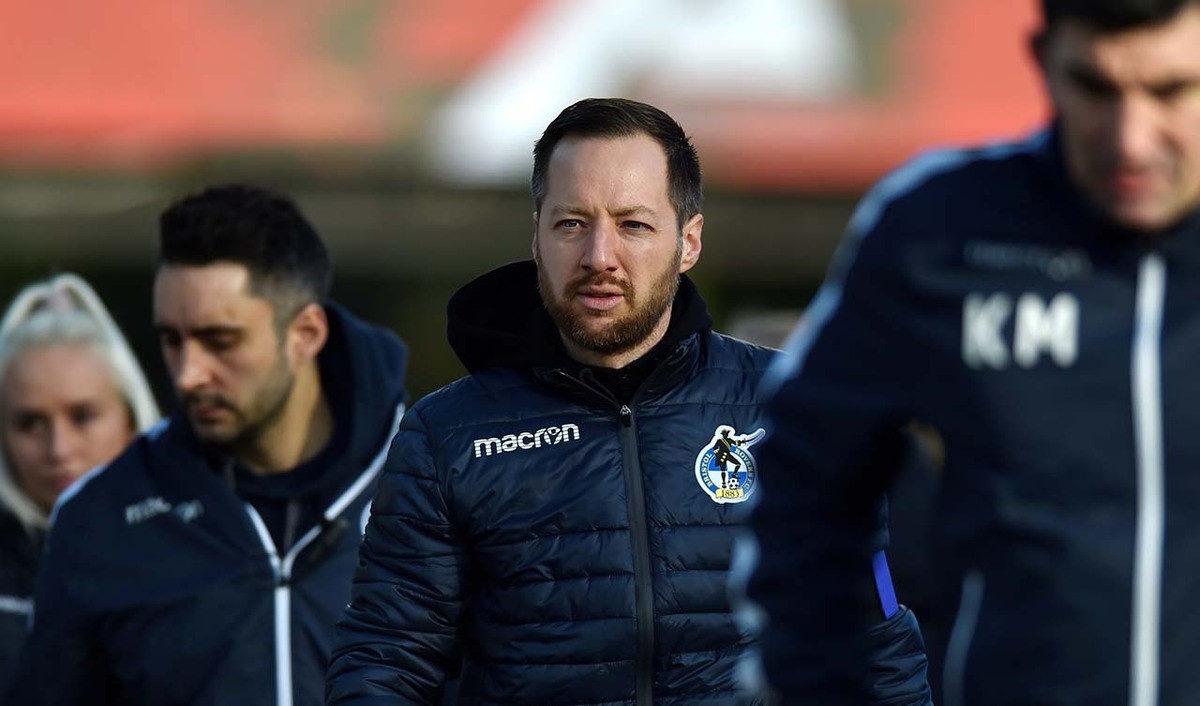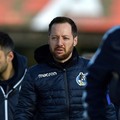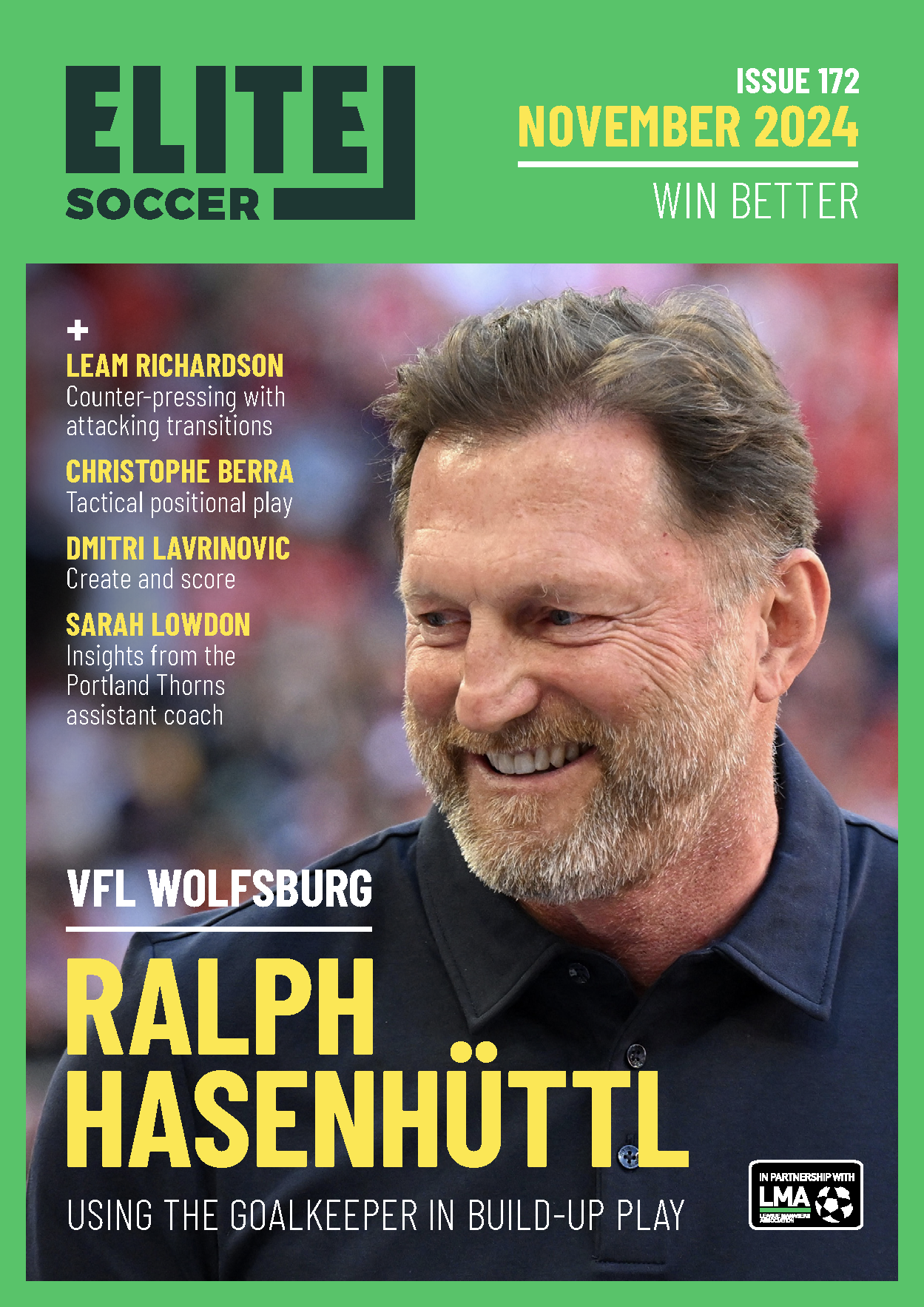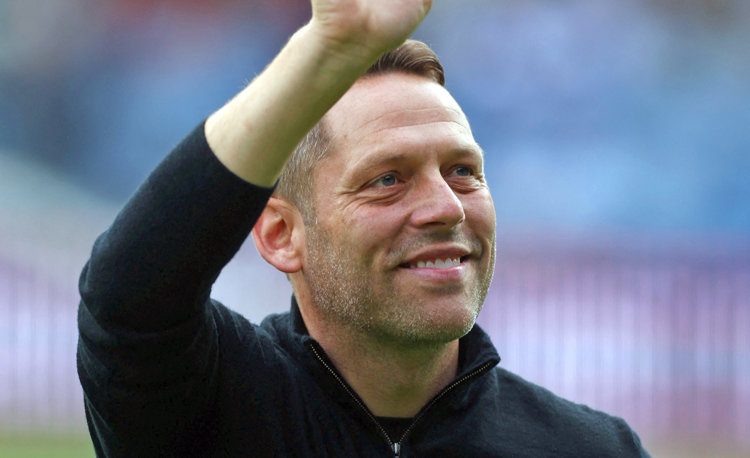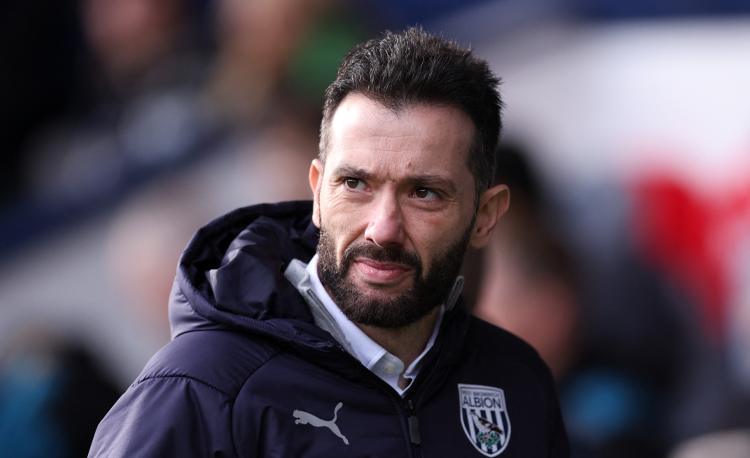You are viewing 1 of your 1 free articles
Intense pressing and recovery
This session focuses on pressing and recovering with intensity. Within the session there is a position-specific element, where the players are broken down into groups and the situations are specific and functional.
| Area | Up to three quarters of pitch |
| Equipment | Balls, bibs, cones, poles, 4 small goals, 2 full size goals |
| No. of Players | Up to 20 players + 2 goalkeepers |
| Session Time |
Defenders: 20mins, Midfielders: 20mins, Forwards: 20mins, Pressing intensity: 20mins, 11v11 pressing intensity: 20min |
This session focuses on pressing and recovering with intensity. Within the session there is a position-specific element, where the players are broken down into groups and the situations are specific and functional. From these position-specific drills the players would then come back together as a full squad for a possession session and then a conditioned 11v11 with the continued emphasis on pressing and recoveries.
This session is directly relevant to every game and puts players into scenarios that they will face on a regular basis. All of the elements are specific to the game and a high level of detail can be put into the session. It is a very challenging session, both physically and psychologically. Key tactical principles can be worked on, both specific to the individuals and to the team as a whole. Technically, there is a high level of difficulty due to the nature of the pressing and space constraints.
The main emphasis of the session is improving the efficiency with which possession can be regained. Each activity within the session has a transition element, as it is something I believe in strongly – the reaction, the thought process, the next phase of the game.
It is also important to be realistic and understand that every player and every team will have to make recoveries during every single game. Preparing them for this in training is important, as it builds the physical and psychological resilience required during matches.
The 11v11 work is always based around the key principles highlighted but also focused on the next match. For example, the general formation and principles of the opposition will dictate how the press is structured tactically.
DEFENDERS PRESS AND RECOVER
We set up in an area of 18x10 yards with a target goal at one end and a target goal in each corner of the other end. We’re using six outfield players, split into three blue defenders and three red attackers.
One of the attackers is positioned at the side of the area. He starts play by passing into the first of two attackers waiting at the top of the area between the two target goals. The receiver controls the ball and attacks the one active defender, who starts in the centre of the playing area. The attacker tries to get past the defender to score in the bottom goal, as shown [1], playing a one-two off the team mate who originally served the ball in from the side.
1
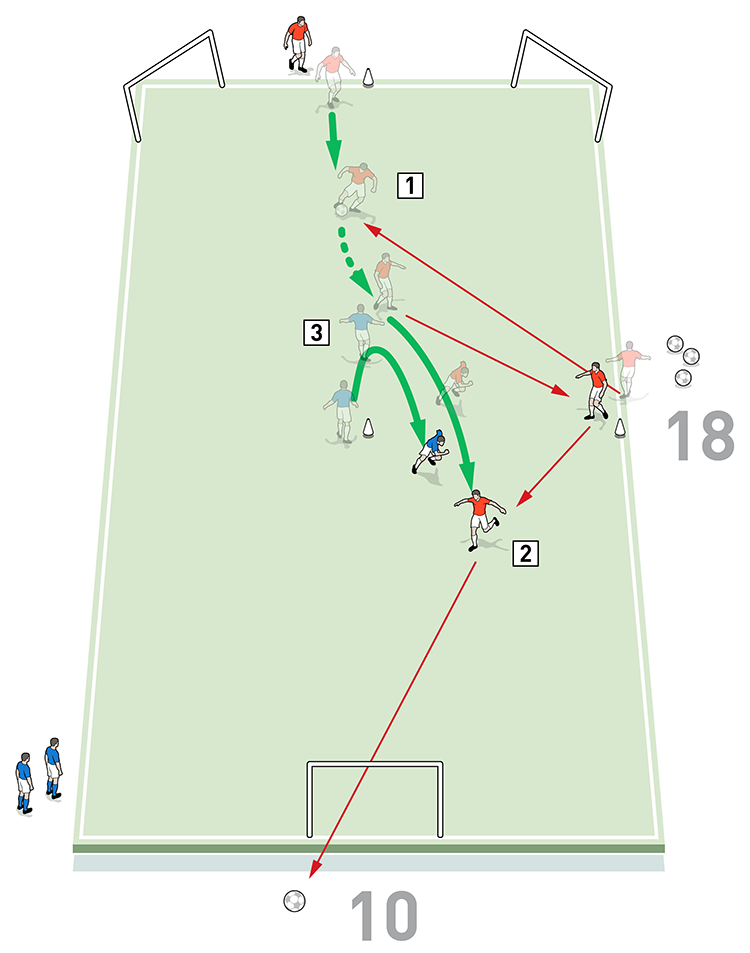
2. The attacker tries to get past the blue defender to score in the bottom goal, playing a one-two off his team mate at the side
3. The blue defender presses quickly and then makes a recovery run, trying to catch the attacker. If he wins possession, he clears the ball or passes into one of the target goals at the top
If the defender wins possession, he clears the ball out of the area or finds a pass into either of the two target goals at the top of the playing area.
We rotate attacking players into the different starting positions and a different defender steps into the active pressing and recovery role each time.
What are the key things to look out for?
We want to see the defender pressing hard, working up to the ball with speed using small steps to allow a quick set. The defender must block the line to the goal and work their feet so they are able to quickly drop or change direction in response to what the attacker does.
When the attacker plays a one-two with the side player, the defender should instantly drop and adjust quickly, turning into the attacker to see him and block his run rather than turning away and being blind to his movement. If the defender is beaten by the run of the attacker, he must make an intense recovery run to try to cut off the path to the goal and apply as much pressure as possible to the attacker.
MIDFIELDERS PRESS AND RECOVER
We set up in an area of 22x18 yards including a 5-yard end zone at each end. Two goals are positioned at each end. We’re using 12 outfield players, split into two teams of six. Each team has four midfielders in the central zone and two forwards in the end zone they are attacking.
The coach starts play by passing into one of the teams in the central zone and the possession team go 4v4 against their opponents, attempting to break lines with a pass into their forwards in the end zone. Before they are free to shoot at goal, the receiving forward must transfer the ball to the other forward, as shown [2].
2

2. The red possession team go 4v4 against their opponents in the central area. They must create an opportunity to break lines with a pass to their forwards in the end zone
3. Before the reds are free to shoot at goal, the receiving forward must switch the play to the other forward
4. If beaten by the through pass, the midfielders can recover into the end zone to try to intercept the ball or disrupt and pressure the forwards
If beaten by the through pass, the midfielders can recover into the end zone to try to intercept the ball or disrupt and pressure the forwards. If they win possession in the central zone, their first option on the transition should be to break lines with a pass to their forwards, but if this is not possible, they should pass the ball to retain possession in the central area until an opportunity arises to play the through ball.
What are the key things to look out for?
We want to see the defending midfielders working hard to press the ball and force turnovers. They should show intelligence when pressing and block the passing lines through to the forwards.
The defending midfielders should work as a unit, covering and balancing behind the pressing player and screening the pass through to the forwards, while being ready to press their direct opponent. If their line is broken, they must immediately react and drop quickly, trying to get behind ball, unsettle the play and win possession.
FORWARDS PRESS AND RECOVER
We set up in an area of 20x10 yards, marking a triangle with three cones positioned 10 yards apart. A target goal is 10 yard from the triangle.
We’re using four outfield players, with the three red defenders starting with one on each cone and the blue forward is in the centre of the triangle. The red on cone 1 starts with the ball and serves it to the player on cone 2, who passes to cone 3. The ball is then played back to the player on cone 1.
The blue forward must press the passes between the red defenders, as he would in a game. He starts by pressing the first pass to cone 2 and when the ball is shifted across to cone 3 he must make a decision on whether to try and intercept the ball or recover back to pressure the original server on cone 1. If the blue forward wins possession, he must try to score with a quick pass into the target goal, as shown [3].
3

2. The defender on cone 2 passes to cone 3. The ball is then played back to the defender on cone 1
3. The blue forward presses the passes between the red defenders. After pressing the first pass he must decide whether to intercept the second pass, or, as here, recover back to pressure the original server
4. If the blue forward wins possession, he must try to score with a quick pass into the target goal
We rotate positions regularly and work the ball in both directions around the triangle.
What are the key things to look out for?
We want to see the forward anticipating the movement of the ball and reading the cues so he can travel early and press as aggressively and as quickly as possible. He should take any opportunity to win possession – from a bad touch or by reading the pass.
PRESSING INTENSITY
We set up in an area of 28x28 yards with a five-yard gate on each of three sides and a further two five-yard gates on the remaining side, as shown. We’re using 20 players split into a team of 10 blue defenders and a team of 10 red attackers. Five of the blue defenders start in the main area and the remaining five are target players, with one in each of the five gates. All 10 of the attackers are in the main area.
Play starts with the coach serving the ball into the attackers, who have a 10v5 overload in the main area and must pass to keep possession from the five pressing defenders. To win, the defenders must clear the ball out of the area three times, or gain possession and make three successful passes to the target players in the gates outside the area, as shown [4].
4

2. The five pressing defenders must try to win the ball. If they succeed, they should pass to one of the target players in the gates. If this is not possible, they should clear the ball out of the area
The teams switch roles after both sets of five defenders have had a turn pressing in the main area.
What are the key things to look out for?
We want to see the defenders pressing as a unit.
The nearest player should get pressure on the ball as quickly as possible to stop switches of play. Supporting defenders should push in and leave the furthest opposition players, maximising pressure around the ball. The furthest defenders from the ball should talk from behind as the pressers are going in, dictating and encouraging the press.
If the ball is switched, the defenders should work hard to recover and get pressure on the ball again as quickly as possible.
When the ball is won by the defenders, we want to see composure and good decisions made on the transition; the first option should always be to find one of the target players with a pass, but if this is not possible they should ensure an effective clearance out of the area.
11v11 PRESSING INTENSITY
We set up on three quarters of the pitch: half the pitch is for the main play, plus there is an unopposed 25-yard scoring zone for the attacking team beyond the halfway line. We position a goal and a goalkeeper at each end. We are using 20 outfield players split into two teams of 11 including keepers. All outfield players start in the full half, set up as if they were playing an 11v11 game.
Play starts from the keeper in the full half and the red attacking team builds play through the blue defending team and attacks towards the halfway line. The defending team attempts to win possession and if they succeed they quickly transition to attack.
However, once beyond the halfway line, the red attackers become unopposed and the blue defenders are unable to enter the scoring zone to make recovery runs, as shown [5]. This reinforces the importance to the defending team of pressing from the front and regaining possession as quickly as possible.
5

2. The blue defending team must read the triggers and press aggressively in an attempt to win possession. If they succeed, they quickly transition to attack
3. The blue defenders must show compactness vertically between the units and compactness across the pitch when the ball is wide
4. Once beyond the halfway line, the red attackers are unopposed as the blue defenders can’t enter the scoring zone. This shows the importance to the blues of pressing from the front
What are the key things to look out for?
We want to see the defending team creating lots of opportunities to press by inviting short passes initially; they should be reading the triggers that let them know their opponents are going to release the ball and they should press quickly to get pressure on the ball. We also want to see compactness vertically between the units and across the pitch when the ball is wide.
Players must demonstrate the mentality to regain possession, being individually aggressive with the press. The speed and quality of the transition to attack is also vital and when counter-attacking they should look to attack spaces and create scoring opportunities as quickly as possible. If they are unable to create a quick chance, then they should retain possession and look to find another way to penetrate.
Related Files
Editor's Picks
Using the goalkeeper in build-up play
Pressing principles
Intensive boxes drill with goals
Penetrating the final third
Creating and finishing
My philosophy
Pressing initiation
Compact team movement
Defensive organisation
Coaches' Testimonials

Alan Pardew

Arsène Wenger

Brendan Rodgers

Carlos Carvalhal

José Mourinho

Jürgen Klopp

Pep Guardiola

Roy Hodgson

Sir Alex Ferguson

Steven Gerrard
Coaches' Testimonials

Gerald Kearney, Downtown Las Vegas Soccer Club

Paul Butler, Florida, USA

Rick Shields, Springboro, USA

Tony Green, Pierrefonds Titans, Quebec, Canada
Join the world's leading coaches and managers and discover for yourself one of the best kept secrets in coaching. No other training tool on the planet is written or read by the calibre of names you’ll find in Elite Soccer.
In a recent survey 92% of subscribers said Elite Soccer makes them more confident, 89% said it makes them a more effective coach and 91% said it makes them more inspired.
Get Monthly Inspiration
All the latest techniques and approaches
Since 2010 Elite Soccer has given subscribers exclusive insight into the training ground practices of the world’s best coaches. Published in partnership with the League Managers Association we have unparalleled access to the leading lights in the English leagues, as well as a host of international managers.
Elite Soccer exclusively features sessions written by the coaches themselves. There are no observed sessions and no sessions “in the style of”, just first-hand advice delivered direct to you from the coach.
